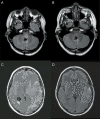Bevacizumab for pediatric radiation necrosis
- PMID: 32765892
- PMCID: PMC7393279
- DOI: 10.1093/nop/npz072
Bevacizumab for pediatric radiation necrosis
Abstract
Background: Radiation necrosis is a frequent complication occurring after the treatment of pediatric brain tumors; however, treatment options remain a challenge. Bevacizumab is an anti-VEGF monoclonal antibody that has been shown in small adult cohorts to confer a benefit, specifically a reduction in steroid usage, but its use in children has not been well described.
Methods: We describe our experience with bevacizumab use for symptomatic radiation necrosis at 5 institutions including patients treated after both initial irradiation and reirradiation.
Results: We identified 26 patients treated with bevacizumab for symptomatic radiation necrosis, with a wide range of underlying diagnoses. The average age at diagnosis of radiation necrosis was 10.7 years, with a median time between the last dose of radiation and the presentation of radiation necrosis of 3.8 months (range, 0.6-110 months). Overall, we observed that 13 of 26 patients (50%) had an objective clinical improvement, with only 1 patient suffering from significant hypertension. Radiological improvement, defined as reduced T2/fluid-attenuated inversion recovery signal and mass effect, was observed in 50% of patients; however, this did not completely overlap with clinical response. Both early and late radiation necrosis responded equally well to bevacizumab therapy. Overall, bevacizumab was very well tolerated, permitting a reduction of corticosteroid dose and/or duration in the majority of patients.
Conclusions: Bevacizumab appears to be effective and well-tolerated in children as treatment for symptomatic radiation necrosis and warrants more robust study in the context of controlled clinical trials.
Keywords: bevacizumab; dexamethasone; pediatric brain tumors; radiation | radiation necrosis.
© The Author(s) 2020. Published by Oxford University Press on behalf of the Society for Neuro-Oncology and the European Association of Neuro-Oncology. All rights reserved. For permissions, please e-mail: journals.permissions@oup.com.
Figures

References
-
- Drezner N, Hardy KK, Wells E, et al. . Treatment of pediatric cerebral radiation necrosis: a systematic review. J Neurooncol. 2016;130(1):141–148. - PubMed
-
- Foster KA, Ares WJ, Pollack IF, Jakacki RI.. Bevacizumab for symptomatic radiation-induced tumor enlargement in pediatric low grade gliomas. Pediatr Blood Cancer. 2015;62(2):240–245. - PubMed
-
- Plimpton SR, Stence N, Hemenway M, Hankinson TC, Foreman N, Liu AK.. Cerebral radiation necrosis in pediatric patients. Pediatr Hematol Oncol. 2015;32(1):78–83. - PubMed

